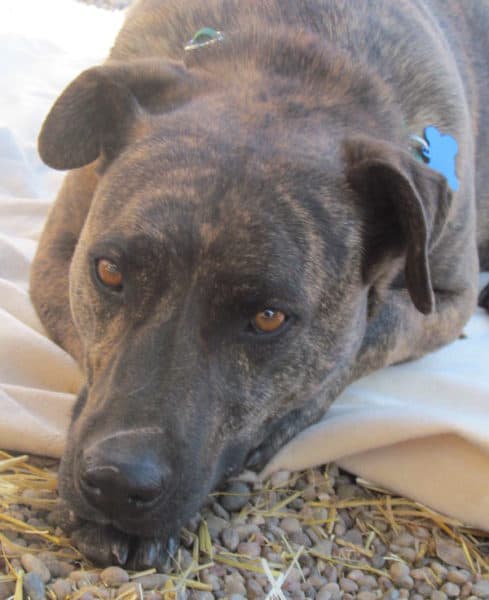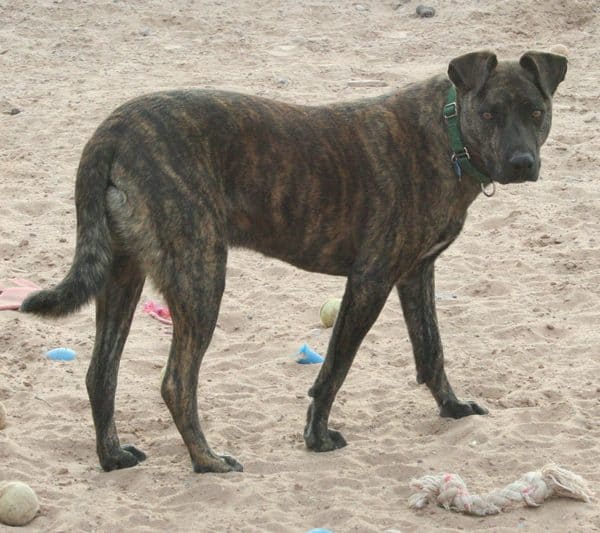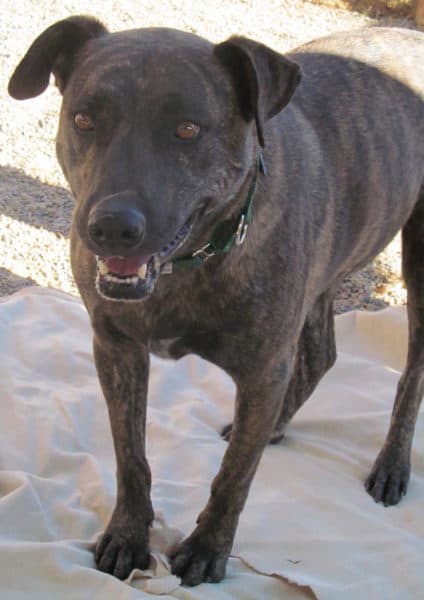When addressing issues with pets, often the greatest challenge is in finding a solution that the people are both able and willing to use. This may have nothing to do with their love or caring for the pet, but more with one’s nature, habits, and abilities.
Alfie’s Beginnings
Back around 2007 there was a chained mama dog in Springer, NM, with 6 pups. A rescue took them in, where they all soon came down with Parvo on Thanksgiving, and 3 of them were lost. Due to the recovery time and quarantine needed, these 6-week old pups weren’t ready for adoption until nearly 5 months old. At which point, all 3 of them were adopted.
Gone!
After nearly 3 years with his adopted family, Alfie was stolen from them. It was nearly two years later that the NM Dog Napper was identified, having taken about 60 dogs. With rescues called in to assist, they found one of the dogs was a large, very fearful, and quite unsocialized guy named Alfie. While he had a microchip, it was still registered to the rescue that adopted him out, which had closed years before. Fortunately, one of the people helping had worked at that rescue and recognized Alfie.
When they returned to take custody of Alfie, the property owners let him loose into the forest. Fortunately, they managed to get close enough to get him. Although his owner had fallen on hard times, they never lost hope and welcomed Alfie back
The Rescue

At this point, Alfie was terrified of everyone and everything. The rescue worked daily with Alfie for 6 weeks, with his family coming to visit. They brought in other dogs and tried to explain to the children that Alfie was not the same dog that they used to know. After some improvement, they brought Alfie back home, and just hoped that he would settle in.
When Alfie Came Back Home
About two months later, I received a call from that rescue, to see if I could help with a very scared dog, who had been stolen and was now home. When I first met Sonya, she said that Alfie was still very difficult to approach and he’d run from her. She would open the back door to let him go outside, but that’s about the extent of it, and she’d have to herd him back into the house. Alfie was just terrified of the front door, and wouldn’t go near it, so they could never even try to walk him outside. He seemed so scared of cars or most anything in the world.
Having worked with this rescue before, I knew they had no idea of how to help a dog like this. I used to hope they would call me in on the first week, but that rarely happened, even in the following years.

After a brief assessment, I spent some time explaining and demonstrating to Sonya what Alfie will need, and how much time it’s likely to take. She was surprised I got Alfie to come over to me, but he did show interest and quickly recovered when scared. Although I added a few items, what she was currently doing with Alfie was fine. But his progress was much slower than I would have expected.
After monitoring the situation for a few weeks, I suggested that Alfie come to visit me for a week or so. That I might be able to help him more quickly, and that I had a training dog who would assist here. My biggest concern was while watching Sonya do some of the exercises that I suggested, that her body language and reactions were hesitant and nervous enough that Alfie was becoming too scared to learn.
Now, this Alfie was still terrified of the front door, and weighed about 80 pounds. So I got it all prepared, took a deep breath, and rapidly shuffled to my car with Alfie in my arms. Once inside, with the doors shut, he just settled down as expected.
Changing Alfie
Bringing Alfie here, it took my dog all of two minutes to assess the situation, and Alfie was fine with him the entire time. As time went on, he adjusted his behavior to Alfie’s interest level and what he was able to handle.
By the second day, after leaving Alfie out back to potty, he was already starting to come back in when called. Up to then, you’d have to go outside and sort of herd him into the house, as he was used to. He was introduced to a leash in the house, then in the back yard. Then very short walks outside, and brief trips into and out of the car while sitting in the driveway. For each item he was scared of, Alfie was given enough encouragement and support that he could move ahead, taking things in small bites.
I think Alfie stayed for only five days, but it all changed in that time. When I would then pick up his leash, he’d jump up in excitement and run to the front door. He loved car rides, walking on the grass in parks, and even exploring stores. While he was so scared the first time outside of Lowes, with some encouragement his curiosity got the better of him, and in he went. The next day, tackling PetSmart. At first stopping every ten feet, then 20, then, on he went.

While I could easily call him into the house, he still needed a very soft approach. He also sometimes hesitated in the backyard when called. These new things were now competing with long-held behaviors. However, outside and away from the house, we had a different dog. This was all new behavior he was learning, and you’d have a hard time finding a happier and more excited guy!
That is an important distinction here in learning and behavior conditioning. While it might take me a month or so to get Alfie fully comfortable in the house, learning some of the outside world took less than a week. And this same principle applies to most fearful dogs, in that following their interests to learn new things is the best first step. And once those new behaviors are well learned, you can start applying them to situations where he’s still uncomfortable.
As an aside, no treats, clickers, special collars or harnesses, were used anywhere in this process. While treats could have been used, the distraction would have slowed down his progress.
Back Home Again
I would have kept Alfie for another two weeks, but Sonya missed him so much that he returned home after only five days. When I first brought Alfie back into her house I expected some abrupt changes. And, sure enough, as soon as Alfie walked through her doorway, Alfie ignored all the stuff he learned in my house and became the old and scared Alfie. I really wish I could have taken a before and after video of that transformation. Even his body language and how he moved and carried himself changed back to what he was used to in that situation.
I explained that he still has the new behaviors and that this will very slowly change. In the meantime, I had her pick up a leash. Since everything having to deal with the outside was new behavior for him, it had no competition from old behaviors. So, Alfie just ran over to the door! And her taking Alfie for walks, and car rides going places, all of that part was just fine!
But, as much as she loved him, it took several more years for Alfie to continue to slowly improve. Even if she and I were to follow the exact same instructions, Alfie’s response to each of us would be very different. And there’s often nothing you can do about that, but to just try and work with it, and do the best you can. If we look back to where she was too nervous to let him stay more than only five days, that same thing would make it very slow for Alfie to learn there. For that same response showed in her body language each time Alfie would hesitate, and he responded.
I kept in touch with them for a few years after, and Alfie did continue to slowly improve.
But Some Will Walk Away
For every case like Alfie, it seems to me that I’ve seen ten others that just walked away. The people had tried for a long time with no success and doubted that anything could change. They may have contacted (sic) Behavior Professionals and were told it would just take many months, and often years. They are so certain of this that they won’t try any further.
Of course, the same thing can also happen with some rescues and shelters. However, as they really need to keep those dogs moving, they will often keep trying. So, most of these cases will come from them, such as the rescue who called me on Alfie.
And people often do not learn. That same rescue had a nervous dog with a nervous foster. They were sent to a dog training class, and the instructor couldn’t safely get near the dog. I then took the dog outside and away from the foster, and she started to calm down, but the rescue just wouldn’t hear of it. Nothing changed for some time after, until the foster gave up and the rescue sent the dog to another foster, one who was always happy and relaxed. In a few weeks, the dog seemed happy and friendly.
Not the end of the story, of course. Only just the starting point for the dog to begin learning social skills and how to deal with the world. But, as the rescue then felt all was fine, I never heard if that ever happened.
